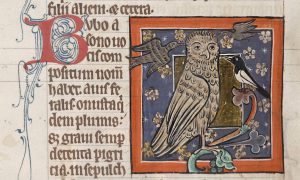A Look At Medieval Tweets

Exploring the strange world of ‘bird debate poetry’.
If you thought screaming, way-too-long Twitter fights were a new phenomenon, then I regret to inform you that it reaches back much further, to a time well before phones, the internet, and even electricity. Indeed, the first angry tweets were inscribed by hand during the Medieval period. Enter bird debate poetry, a genre where birds argue with each other.
It all began with The Owl and The Nightingale, written by an anonymous author. While roughly 60 pages of 12th-13th century poetry about two birds arguing sounds completely boring, this poem is hilarious. It’s essentially a rap battle between two birds, and the oldness of the text only makes it funnier. The birds attack each other relentlessly, but don’t take it from me – here are some of the opening lines:
“The Nightingale clapped eyes on her / & shot the owl a filthy glare, / disgusted by that horrid creature’s / loathsome, nauseating features / “Freak, why don’t you disappear? / It sickens me to see you here.” (lines 29-34, Simon Armitage translation.)
Who knew medieval people had such strange humor? One must suppose they had nothing else to do, or perhaps they were right to find it so funny. Often, the reader is led to envision these little birds “[fly] into a rage” or “about to pop [with rage]”. Really, the word “rage” is used humorously often. Further, the birds admit to themselves again and again that they carry the argument on out of nothing but spite. One must suppose they, too, had nothing better to do.
The Owl and The Nightingale was only the beginning of a centuries-long trend, however. When one considers trends in literature today, they might think of how dystopia has taken over Y/A fiction, how zombie apocalypses dominate horror literature, and so on. The Hunger Games and The Walking Dead were catalysts for these respective crazes, and The Owl and The Nightingale was no different. All thanks to this silly poem, the strange genre of bird debate poetry took a prominent place in the world of Medieval literature.
In fact, the influence of the genre reaches beyond historic popularity. The Parlement of Foules (spelled as The Parliament of Fowls in modern English) by Geoffrey Chaucer contains the earliest reference to Valentine’s Day as a special day for lovers. Written in the 14th century, the poem contains 700 lines detailing an argument between several birds about their choices of mate. Thus, the link between romance and the popular holiday may not have existed without this strange medieval fad.
This is all well and good, but one may ask the question, “Why birds?” The answer is simple – because they tweet the most.

